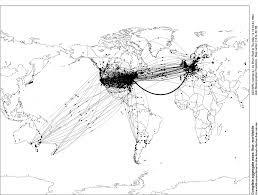I recently attended the 2015 Conference of the Association for the study of the Cuban Economy, where I was on a panel on the future of the Internet in Cuba with two friends who played significant roles in Cuban networking history. A third colleague, Juan Blanco, was in the audience.
 |
| Jesus Martinez, Juan Blanco and Óscar Visiedo |
Óscar and later Jesus were the directors of CENIAI, the National Center for Automatic Interchange of Information, and were responsible for Cuba's first computer network activity. Juan ran political interference for them -- using his social-political contacts to argue for the adoption of email. (Juan says the debate focused purely on email, ignoring the Usenet News groups).
 |
| CENIAI staff, 1990. Photo by Óscar Visiedo, Jesus Martinez second from left in the back row |
CENIAI began networking in 1982 with connections to Soviet and European databases and limited email. By 1992, CENIAI had 62 staff members, and was part of the Ministry of Science, Technology and Environment.
They were not on the Internet, but connected by phone several times a day to exchange batches of email and discussion forum posts. The discussion groups, known collectively as Usenet News, covered a wide variety technical, cultural and political discussion. They were part of an asynchronous global network that used the Unix to Unix copy protocol (UUCP):
 |
| UUCP connections, 1988 |
By 1995, Cuba was among the networking leaders in the Caribbean. CENIAI and three other networks with international UUCP links were transferring over 60 Mbytes of international email and had nearly 2,600 users:
 |
| Monthly international email traffic in 1995 |
Cuba's UUCP connection was to the Association for Progressive Communications (APC) in Canada. APC provided connections for many non-governmental organizations (NGOs) and that attracted the attention of politicians, who saw NGOs as subversive. There was debate and the Interior Ministry argued that material sent to and received from APC should be blocked since it could not be controlled.
Juan Blanco argued that the Ministry of the Interior was only concerned with control of communication at the expense of arresting national development, saying that had their view prevailed when Lenin was around there would be no phone system in the USSR. His argument was effective and the UUCP traffic to APC was allowed to continue.
Óscar Visiedo left for the United States and Jesus Martinez took over as director. Under his leadership, CENIAI established their first Internet connection, a 64 kbps IP link to the US National Science Foundation (NSF) backbone. The cost was born by the NSF International connections program, which connected academic and research networks from 28 nations.
Martinez and his colleagues were proud and happy to be on the Internet, but the Internet was no longer under the radar. In June, 1996, the Executive Committee of the Cuban Council of Ministers issued Decree 209 regulating the use and development of information networks and Internet services within Cuba. The decree established an inter-ministerial commission with responsibility for all matters relating to access to and the information on computer networks of global reach. The commission was to be chaired by the Minister of Metallurgical Industry and Electronics and include Ministries of Science, Technology and Environment, Communications, Interior, Revolutionary Armed Forces and Justice. Many interests were represented.
It appears that power was consolidated in January 2000, when Decree Law 204 created the current Ministry of Informatics and Communications (MIC) with control over Information technology, the electronics industry, telecommunications, broadcasting, radio spectrum and the postal service – traditional media and computer networks.
Today, the Cuban Internet is far less developed than would be expected in a nation with Cuba's level of education and development. This is due to the embargo, the poor economy at the time of Cuba's connection to the Internet and government fear. All three must change for the Cuban Internet to thrive.
The fear was based in part on the collapse of the Soviet Union. In October 1997, Raúl Castro said:
Glasnost, which undermined the USSR and other socialist countries, consisted in handing over the mass media, one by one, to the enemies of socialism.In a 1995 interview, Cuban researcher Gillian Gunn noted that since the spring of 1993, there had been Cuban government memos calling for increased audit and control of NGOs and Raúl Castro commented on her report, noting that NGOs were a threat.
The Cubans may also have been aware of the role of the global UUCP network in thwarting the 1991 Soviet Coup attempt against Gorbachev.
In spite of these reservations, there was debate within Cuba. Óscar Visiedo demonstrated the network for Fidel Castro, who he says was positive. (Fidel inaugurated the Youth Computer Clubs). At the same time as Raúl Castro spoke out against the Internet, pragmatic Finance Minister (?) Carlos Lage reiterated Juan Blanco's view, saying:
One telex can cost twelve dollars [whereas] the same message costs 75 cents in the form of a fax and 3 cents via the Internet ... in spite of our blockaded circumstances, we are in a relatively good position [to face the challenges of such scientific and technological changes], due to the educational and scientific work developed by the revolution.This time the hard liners prevailed, deciding to limit access to the Internet, but today US support for the embargo is declining, the Cuban economy is in better shape than it was in 1996 and it will improve further post December 17. One issue remains -- does Raúl Castro still fear the Internet? Does he have reason to do so?
No comments:
Post a Comment